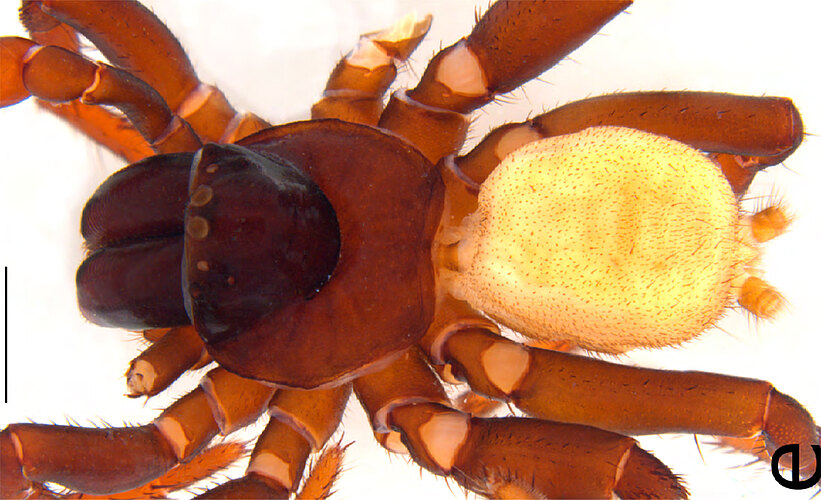Earth Mouse Spider Missulena terra Marsh, Stevens & Framenau, 2023
Fauna Portal species: 12679Diagnosis
(after Marsh et al. 2014): Males of M. terra are most similar to seven other species which share a brown carapace and chelicerae: M. durokoppin, M. faulderi, M. harewoodi, M. leniae, M. melissae, M. pinguipes, and M. rutraspina. Of these, they differ from M. durokoppin, M. faulderi, M. leniae, and M. rutraspina by having a rounded rectangular shaped and swollen pedipalp tibia, 1.7 the length times the width, which is distinctly more slender in these other species. They differ from M. pinguipes by having a smooth carapace, which is granulated in M. pinguipes and by the shape of metatarsus IV, which is inflated in M. pinguipes, but not so in M. terra. Males of M. terra differ from M. harewoodi by the lack of retrolateral and dorsal transverse striations on the chelicerae in M. harewoodi. They are further separated by M. harewoodi by the rounded rectangular shape of the pedipalp tibia in M. terra, which is broadly teardrop shaped and narrowed apically in M. harewoodi, and by the shape of the embolus, which has a distinct basal embolar intumesence in M. terra, thickened until around half the embolus length, but is narrower basally in M. harewoodi.
Status
- native
Linnean Holotype
Australia
- Western Australia
Fauna Portal Records
The map shows all records that have been verified as part of the Fauna Portal project and may not represent the true distribution of a species. Specifically, for described species, check the link to the Atlas of Living Australia on this page for potential wider distributions. Fauna Portal Reference specimens and Linnean types are shown in red. If you identified a specimen that exceeds the distribution of an undescribed species as illustrated here, please contact the Fauna Portal team who can assist with the lodgement of the specimen in a public institution and display on the map.
Publications
Araneae (Spiders)
- Actinopodidae
- Anamidae
- Araneae fam. indet.
- Araneidae
- Archaeidae
- Argyronetidae
- Arkyidae
- Barychelidae
- Cheiracanthiidae
- Clubionidae
- Corinnidae
- Cycloctenidae
- Deinopidae
- Desidae
- Dictynidae
- Filistatidae
- Gnaphosidae
- Halonoproctidae
- Hersiliidae
- Idiopidae
- Lamponidae
- Linyphiidae
- Lycosidae
- Mimetidae
- Miturgidae
- Mysmenidae
- Nicodamidae
- Oecobiidae
- Oonopidae
- Oxyopidae
- Philodromidae
- Pholcidae
- Pisauridae
- Prodidomidae
- Salticidae
- Scytodidae
- Segestriidae
- Selenopidae
- Sparassidae
- Symphytognathidae
- Tetrablemmidae
- Tetragnathidae
- Theridiidae
- Thomisidae
- Trachelidae
- Trachycosmidae
- Trochanteriidae
- Uloboridae
- Zodariidae
- Zoropsidae
All classes
- Arachnida
- Crustacea
- Entognatha
- Gastropoda
- Insecta
- Orthoptera - Caelifera (Grasshoppers)
- Hymenoptera excl. Formicidae (bees and wasps)
- Blattodea s. str. (Cockroaches)
- Coleoptera (Beetles)
- Dermaptera (earwigs)
- Diptera (flies, mosquitos)
- Entomobryomorpha (slender springtails)
- Hemiptera - Heteroptera (True Bugs)
- Hemiptera - Sternorrhyncha (aphids, scales etc.)
- Hemiptera - Auchenorrhyncha (cicadas, planthoppers)
- Hymenoptera - Formicidae (Ants)
- Trichoptera (Caddisflies)
- Zygentoma (silverfish)
- Myriapoda

